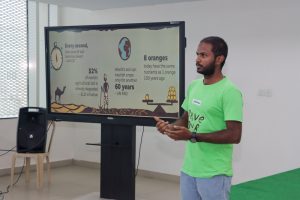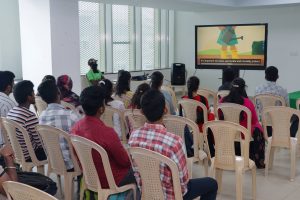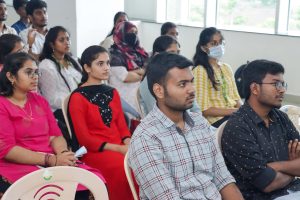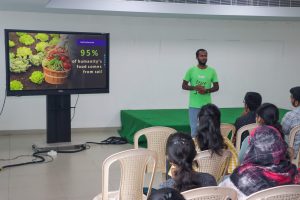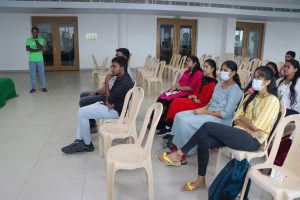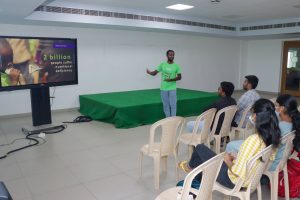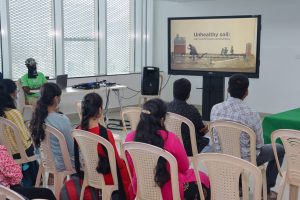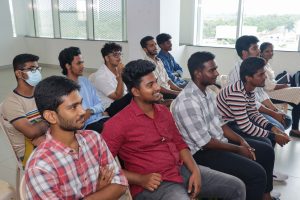SRM-AP All News
ALL News
- Mental health of school students during the COVID-19 pandemic in India September 20, 2022
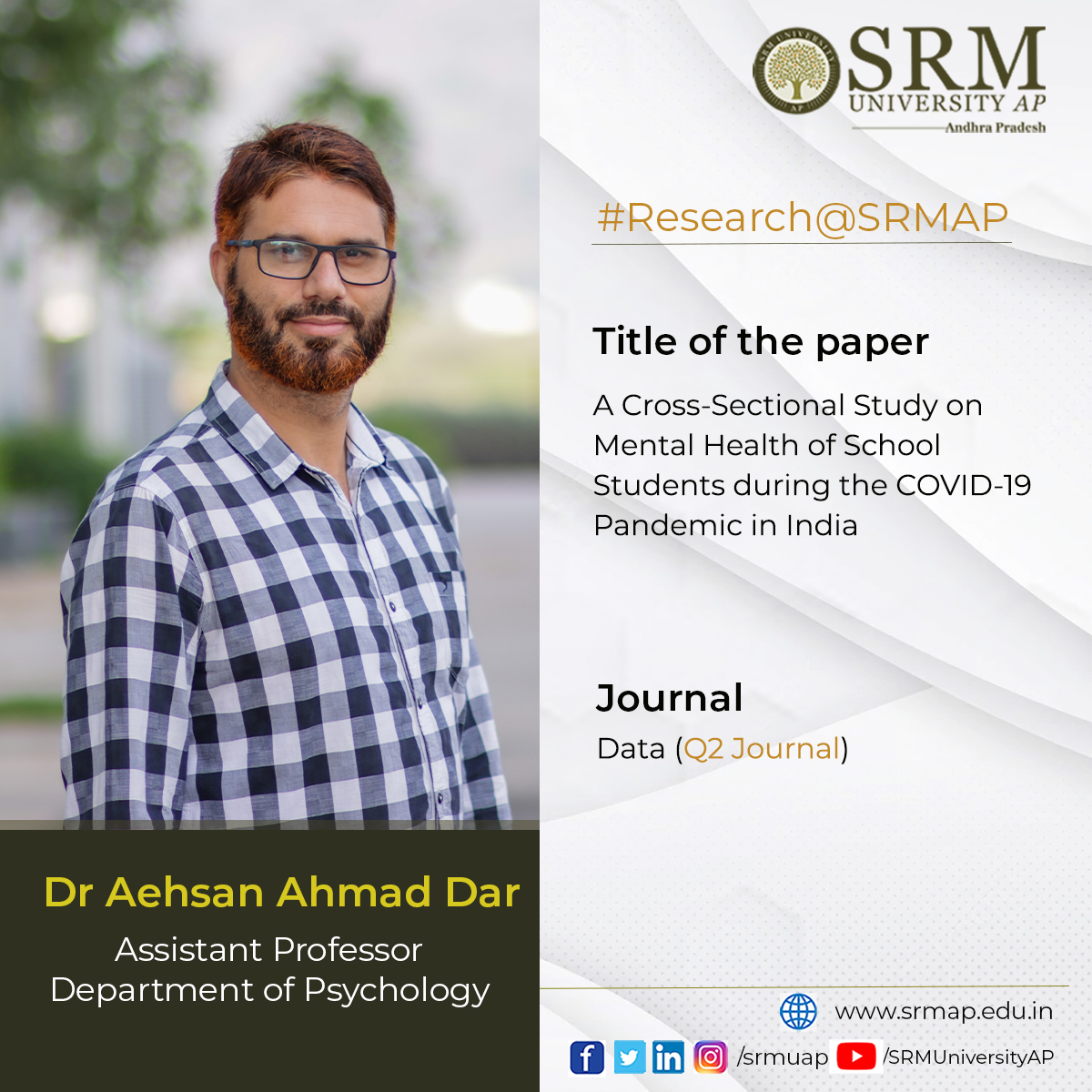
Dr Aehsan Ahmad Dar, Assistant Professor, Department of Psychology, published the article titled “A Cross-Sectional Study on Mental Health of School Students during the COVID-19 Pandemic in India” in the journal Data in collaboration with academicians from different universities across the country and abroad.
The present study estimated the mental health of school students during the COVID-19 pandemic. The findings revealed that the COVID-19 pandemic caused stress which increased the levels of anxiety and depression among the students. However, social support from family and friends was found to be a protective factor for mental health.
The findings of the research will serve as a reliable source of information for mental health professionals and policymakers to better understand the impact of the COVID-19 pandemic and other traumatic experiences on mental health. Therefore, necessary efforts are suggested to provide mental health support services to prevent the development of mental disorders.
Dr Aehsan’s future research plan is to study the mental health of youth and ascertain its risk and protective factors. About 19% of the world’s children live in India, which constitutes 42% of the total Indian population, and nearly half of these children are vulnerable and need care and protection. Due to various traumatic experiences, stress has increased among young people resulting in the development of various physical and mental disorders.
His research will focus on the pathogenic (posttraumatic stress disorder, depression, anxiety, somatization) and salutogenic (posttraumatic growth and resilience) consequences of trauma to help the youth withstand adverse experiences to develop psychological competence. The research will provide insights into the mental health status of youth that would be helpful for the administration, policymakers, and other voluntary organizations to understand effective ways to devise and implement the best intervention programs for maximizing mental health protective factors and minimizing its risk factors.
Continue reading → - Occurrence, environmental risks, and biological remediation of Triclosan September 16, 2022
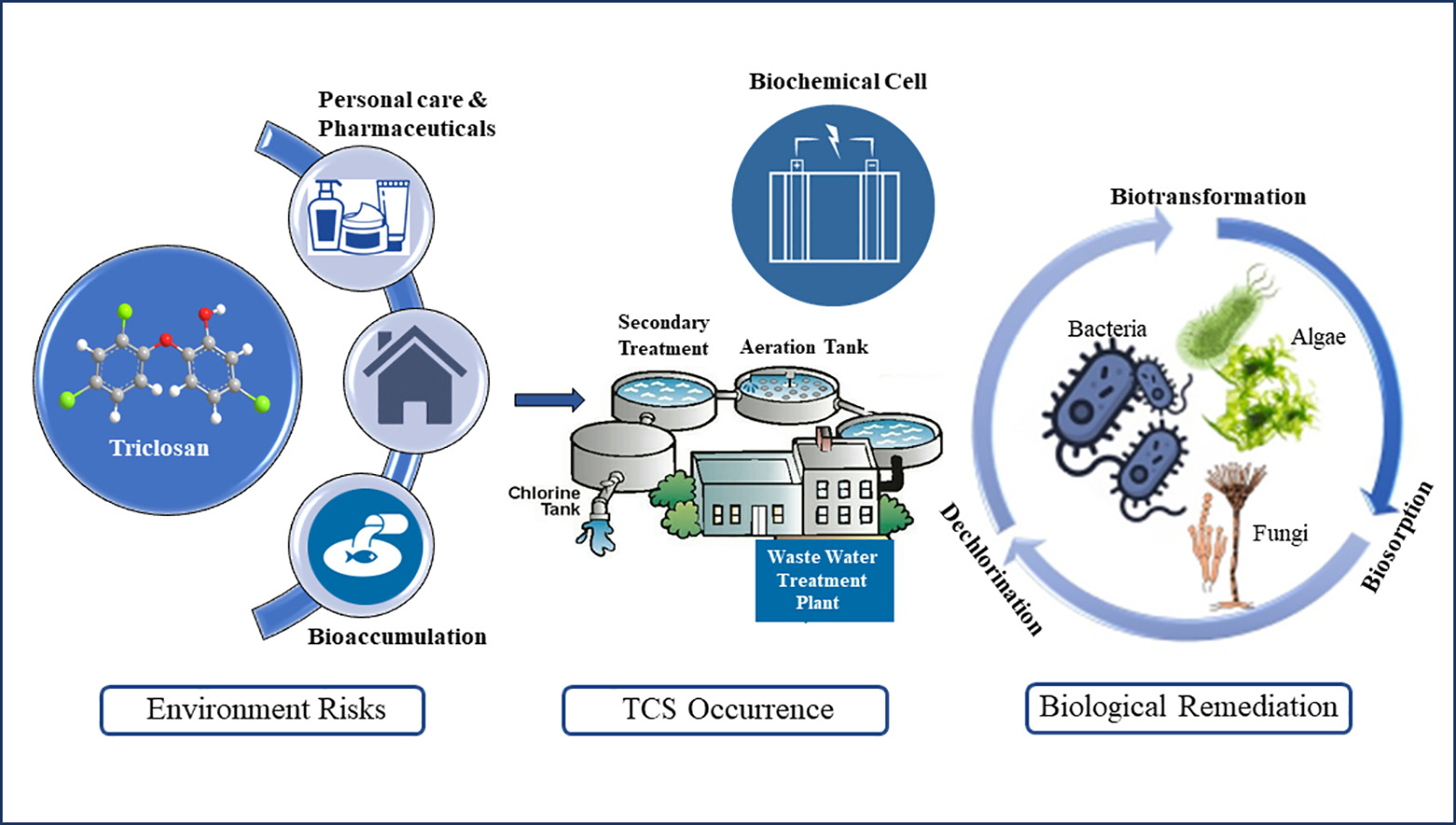
The Department of Environmental Science is glad to announce that Assistant Professor Dr Pankaj Pathak and her PhD Scholar Mr Gopa Nandikesh have published an article titled “Occurrence, environmental risks and biological remediation mechanisms of Triclosan in wastewaters: Challenges and perspectives” in the Journal of Water Process Engineering having an Impact Factor 7.34. The paper was published in collaboration with Dr Lakhveer Singh, Sardar Patel University, Himachal Pradesh.
The paper makes a comprehensive understanding of the disadvantages and consequences associated with the excessive use of Triclosan (TCS), an anti-microbial agent widely used in pharmaceutical and personal care products (PPCPs). The article also suggests various ways to achieve the bioremediation of Triclosan using microbial degraders and the different challenges associated with such practices.
The extensive use of TCS in PPCPs has increased over the past few decades, and its sizeable production and consumption are causing adverse effects on the environment and humans. TCS has been made into the list of emerging micropollutants (EMPs) due to its omnipresence in water resources and even in biological samples such as urine and breast milk. Therefore, it is imperative not only to understand the current status of TCS pollution but their occurrence, exposure routes, and environmental risks to identify remediation technologies for mitigating TCS.
Their research targets to provide cumulative data on the abundance of emerging TCS in water resources and its associated health burdens simultaneously. It is identified that TCS remediation can be achieved through advanced physical and chemical methods such as enzyme oxidation and ozonation. However, there are drawbacks such as high energy consumption and the formation of toxic by-products.
The article endeavours to provide an in-depth understanding of the biological remediation of TCS by microbial degraders as well as its superiority over other remediation techniques. Insights into the various microbial communities such as bacteria, algae, and fungi and their unique bioremediation mechanisms are comprehensively summarised. Moreover, challenges associated with existing bioremediation methods and future perspectives are also discussed in the present work.
Continue reading → - Converting fear into power September 16, 2022
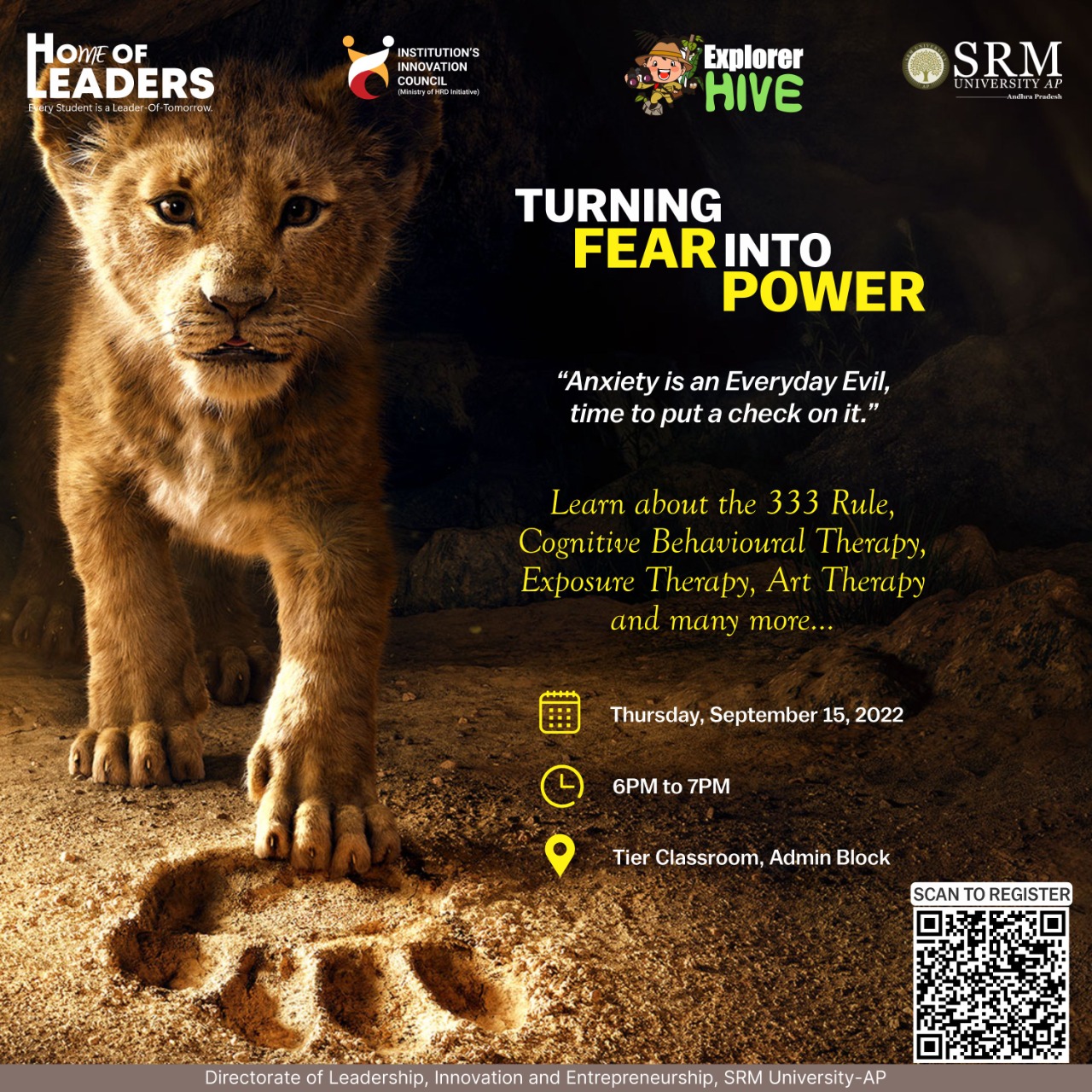 To be a leader, you must act like one and be among leaders, as that is what is demanded by the competitive and dynamic world. The Home of Leaders is a platform designed by students for students to explore beyond the boundaries of the university. It reaches out to corporate and everyday life outside the curriculum.
To be a leader, you must act like one and be among leaders, as that is what is demanded by the competitive and dynamic world. The Home of Leaders is a platform designed by students for students to explore beyond the boundaries of the university. It reaches out to corporate and everyday life outside the curriculum.A fun and knowledge session on Turning fear into power was conducted by Explorer Hive of the Department of Entrepreneurship and Innovation on September 15, 2022, to channel the energy of students into indispensable power. The session was based on the idea to confront anxiety and figuring out the route to a confident self. The session covered topics like the 333 rule, cognitive behavioral therapy, exposure therapy, art therapy, and many more.
Energy flows wherever one’s focus goes. Thus, the concept of the programme was to retain the spotlight on focus-oriented energy utilisation. On a scale of 0 to 10, 0 represents total calmness and 10 represents an utterly disturbed mind. The session featured techniques that can bring anxiety levels from 8 to 3 or even less within a span of 5 to 10 minutes.


Continue reading → - Dr Saleti Sumalatha published two patents in a row September 16, 2022
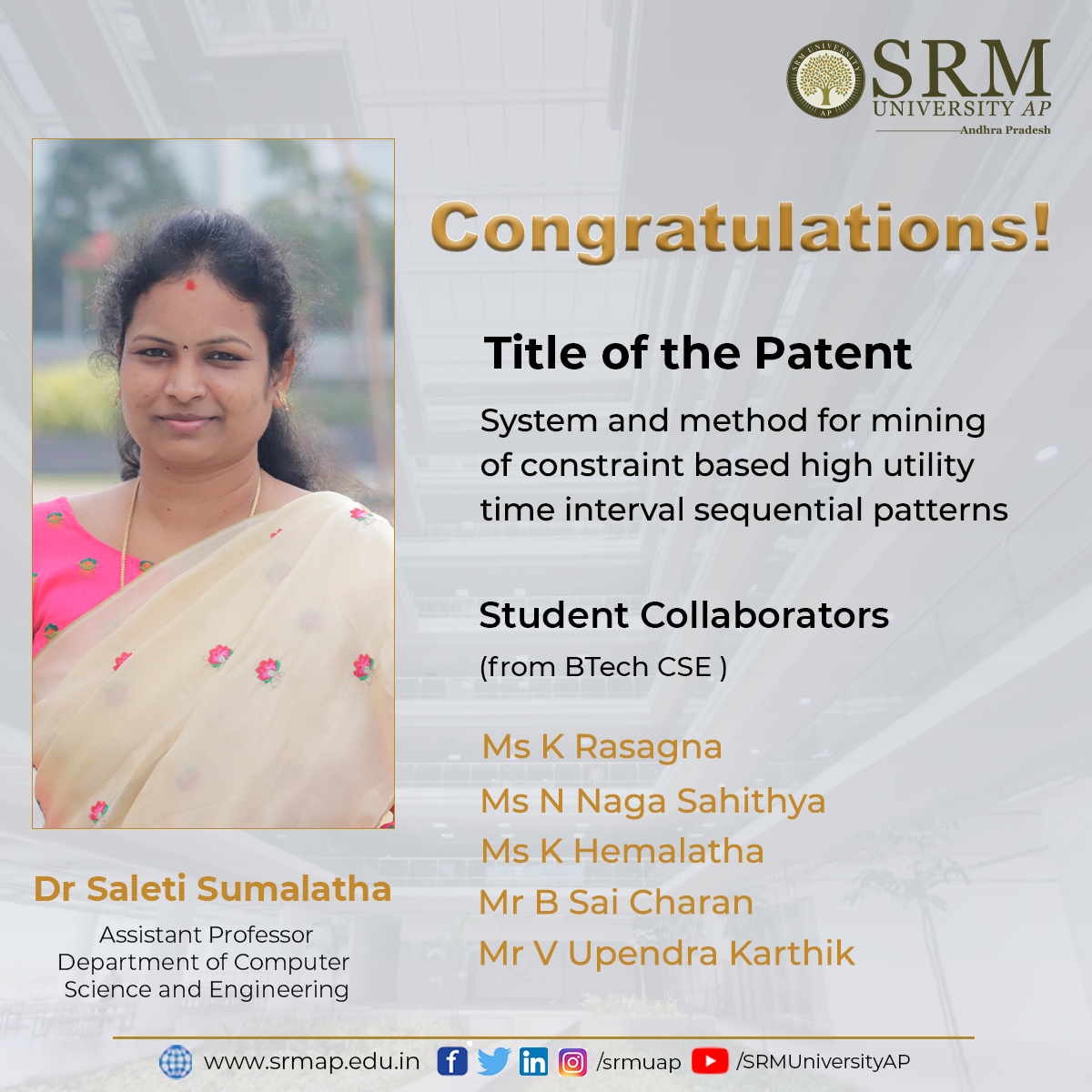
The Department of Computer Science and Engineering is glad to announce that Assistant Professor Dr Saleti Sumalatha and her students got two of their patent applications published in a row. The patent titled “System and method for mining of constraint based high utility time interval sequential patterns” (Application number: 202241044001) was published in collaboration with the BTech students; K Rasagna, N Naga Sahithya, K Hemalatha, B Sai Charan, and Upendra Karthik.
The main intention of the proposed system is to discover the sequences that include the time period between the purchases of each item. For example, if we consider a shop which sells some groceries like Grains, Milk, Yogurt, Bread and Eggs as the set of items in the database. Now, the main aim is to find the time period between the purchases of particular items that are being sold. From this, the shop owner can easily maintain the stock of completed items according to the time period.
For example, an output sequential pattern including time intervals of the form indicates that a customer who purchased item x also bought item y after three months and visited the store again after five months to buy item z. It considers the same utility threshold for each of the items in the database, which shows that each item is assumed to have the same unit profit. This is not convincing as each item is different in real-time applications and should not be treated equally. For example, the sales of” Gold bangles” will produce more profit than the sales of” Cotton Jeans”. In view of this, the research proposes UIPrefixSpan-MMU.
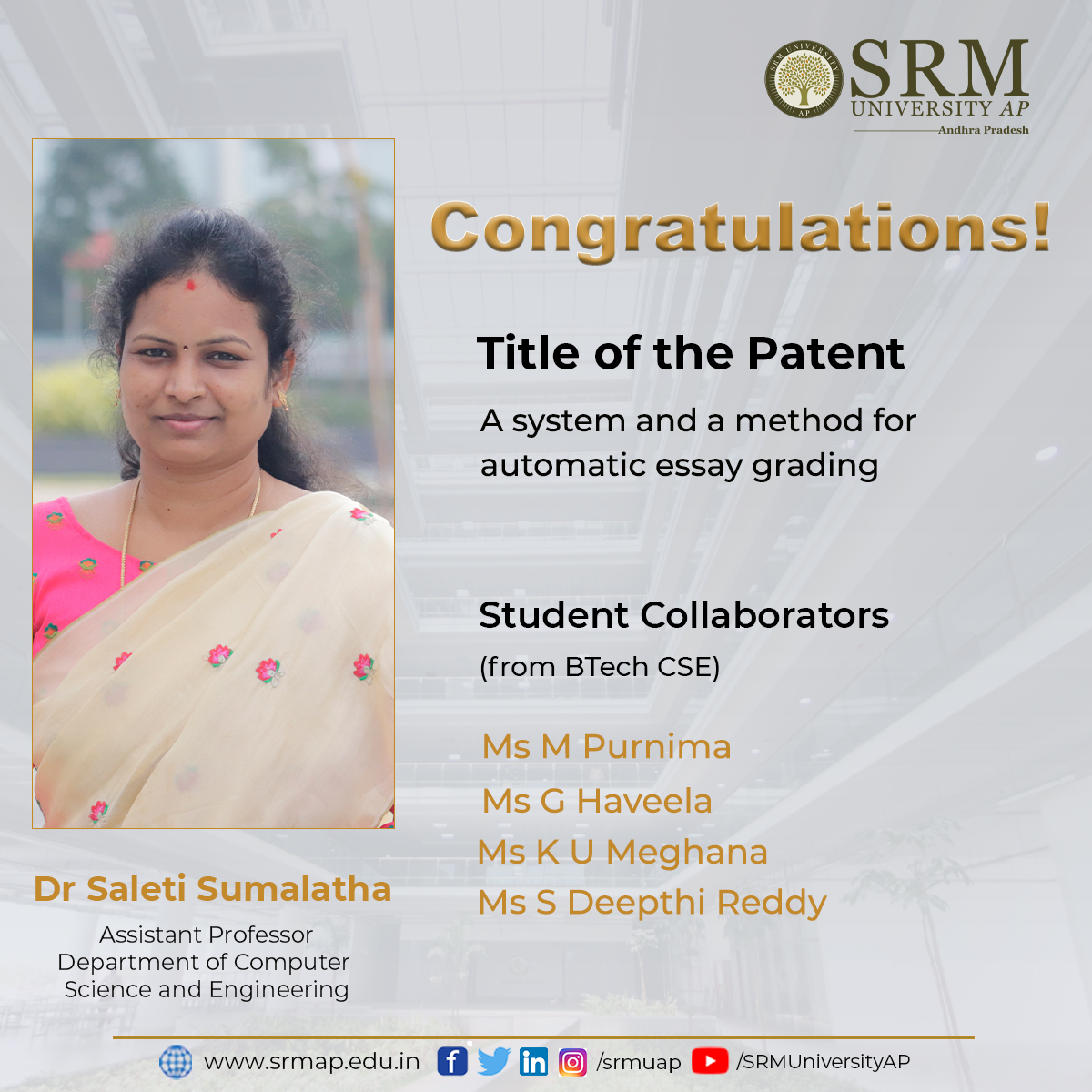
The other patent titled “A system and a method for automatic essay grading” (Application number: 202241043045) was published in collaboration with M Purnima, G Haveela, K U Meghana, and S Deepthi Reddy. Essay grading systems are being adopted by different organisations to reduce the hectic workload from a teacher’s point of view. They made a model which is trained with datasets containing different essay topics and numerous essays with scores varying in a wide range.
Essay grading systems will not only save the time for evaluation but also give accurate results. The output of the system will be quick such that it could evaluate many essays and get trained. This system benefits both the student and the teacher as well. Their model predicts the scores of the essay by comparing them with the features extracted from the trained data. This model can be used to reduce the effort of teachers to grade many essays in a limited time. The work of grading will be fastened and accurate.
Continue reading → - Marketing for Entrepreneurs: Book publication from the Directorate of CR&CS September 14, 2022
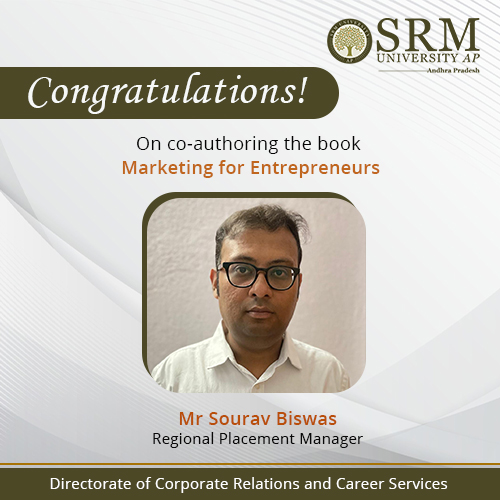 Marketing a product or service is a challenging task in an ever-evolving marketplace. The latest book publication from the Directorate of Corporate Relations and Career Services portrays how marketing and entrepreneurship are not only creative but also cohesive and interesting. Mr Sourav Biswas, Regional Placement Manager of the Directorate of Corporate Relations and Career Services, has co-authored the book Marketing for Entrepreneurs with Dr Punit Kumar Dwivedi, Dr Biswarup Neogi, and Mr Saurabh Bharti. It offers entrepreneurs and intrapreneurs a rich fare of stimulating ideas, a new vision of challenging insight, and the proper marketing and entrepreneurial solutions. It was published by Scientific International Publishing House and launched in August. The book targets an audience with a plan to start innovative ventures in the future.
Marketing a product or service is a challenging task in an ever-evolving marketplace. The latest book publication from the Directorate of Corporate Relations and Career Services portrays how marketing and entrepreneurship are not only creative but also cohesive and interesting. Mr Sourav Biswas, Regional Placement Manager of the Directorate of Corporate Relations and Career Services, has co-authored the book Marketing for Entrepreneurs with Dr Punit Kumar Dwivedi, Dr Biswarup Neogi, and Mr Saurabh Bharti. It offers entrepreneurs and intrapreneurs a rich fare of stimulating ideas, a new vision of challenging insight, and the proper marketing and entrepreneurial solutions. It was published by Scientific International Publishing House and launched in August. The book targets an audience with a plan to start innovative ventures in the future.A brief about the book
Entrepreneurs face most difficulties in two significant areas: selling their products/offerings and finance. Initial stage cash flow is required to develop the product and sustain it. If companies don’t achieve sales, their failure is impending. To bring products or services to the market, entrepreneurs must communicate their offerings to the external environment.
Entrepreneurship and Marketing have traditionally been viewed as two different subjects of study. Increasing awareness of the significance of innovations and entrepreneurship in marketing and the importance of marketing for fruitful entrepreneurial ventures has led to an effort to combine entrepreneurship and marketing as the discipline of entrepreneurial marketing. In the area of entrepreneurial marketing (EM), there seems to be an agreement among researchers and entrepreneurs to undertake marketing in different ways that seem different from the established model of the market.
Mr Sourav Biswas was a member of the IIPC (Industry Institute Partnership Cell) cell as well as a convener of the Innovation council while he started working on the book. He came across many cases where students had started their innovative ideas, which the college funded. But in 90 percent of cases, companies can’t make a profit, or it has been closed within 2-3 years due to a lack of Marketing mix (product, place, price, and promotion). Based on this observation, the authors tried to find a way to help young entrepreneurs to succeed. They envisioned a future where many more entrepreneurs come forward with innovation and proper marketing strategies.
Continue reading → - Effective combinatorial drug therapy for prostate cancer September 13, 2022

Prostate cancer is the second most frequent solid organ malignancy in males worldwide. The risk of causing prostate cancer is increased by age, race, and family history. The U.S. FDA has approved the six most successful drugs, viz., docetaxel, sipuleucel-T, abiraterone, enzalutamide, cabazitaxel, and radium-223. Despite these approved therapies, the disease state remains lethal. The recent publication of Dr Imran Uddin, Post Doctoral Fellow, Department of Physics, “Targeted non-AR mediated smart delivery of abiraterone to the prostate cancer” proposes a combinatorial system against prostate cancer using the FDA-approved drug abiraterone. The paper was published in the Q1journal PLoS ONE having an Impact Factor of 3.75. The research was done in collaboration with Dr Mohd Sajid Khan, Associate Professor, Aligarh Muslim University.
Although abiraterone is an excellent anticancer agent, it causes several side effects and becomes irresponsive after a few months of therapy. They developed a nanomedicine, along with two other components, that will deliver a substantially small dose of abiraterone for treating the same stage of cancer, and the drug will also not be resistant to the cancer cells. The delivery system delivered the drug at a specific site and modified its mode of action. The low dose of abiraterone will also not cause any substantial side effects. The combo was found to be highly biocompatible, nontoxic, and effective.
The proposed nanomedicine with established drug abiraterone, gold nanoparticles, and antibodies against cancer-promoting protein synergistically acted on prostate cancer cells. This synergism potentiated the effect of abiraterone at a very low concentration because other entities also acted via different routes and weakened the cancer cells. The low dose minimized the side effects and maintained patient compliance. This drug was delivered directly to the target, which enabled it to adopt different methods to act on cancer cells. Therefore, the results were promising but further needed to be validated in pre-clinical and clinical studies.
In future, Dr Uddin intends to focus on interdisciplinary sciences. His plans include studying the interface of biology with inorganic nanomaterials, understanding the underlying biological process, and developing new industrially relevant nanomaterials and biomedical aspects. It involves developing nano biosensors for biomolecule detection through the effective integration of the best approaches and expertise in sensor engineering with the vision to take a lead in shaping the future of biomedical monitoring systems. The timely integration of such interdisciplinary approaches will consolidate the application of Lab-on-a-Chip devices for automated biomolecular monitoring.
Abstract of the Research
Prostate cancer is the second-deadliest tumour in men all over the world. Different types of drugs with various delivery systems and pathways were developed, but no one showed prominent results against cancer. Meanwhile, nanotechnology has shown good results against cancer. Therefore, in the given study, citrate mediated synthesized gold nanoparticles (CtGNPs) with immobilized survivin antibodies (SvGNPs) were bioconjugated to the substantially potent drug abiraterone (AbSvGNPs) to develop as a combinatorial therapeutic against prostate cancer. The selected drug abiraterone possesses exceptionally good activity against prostate cancer, but cancer cells develop resistance against this drug and it also poses several severe side effects. Meanwhile, survivin antibodies were used to deliver AbSvGNPs specifically into cancer cells by considering survivin, an anti-apoptotic overexpressed protein in cancer cells, as a marker. The surviving antibodies have also been used to inhibit cancer cells as an immunotherapeutic agent. Similarly, CtGNPs were discovered to inhibit cancer cell proliferation via several transduction pathways. The given bioconjugated nanoparticles (AbSvGNPs) were found to be substantially effective against prostate cancer cells.
Continue reading → - Security concerns in digital image transmission over the internet September 13, 2022
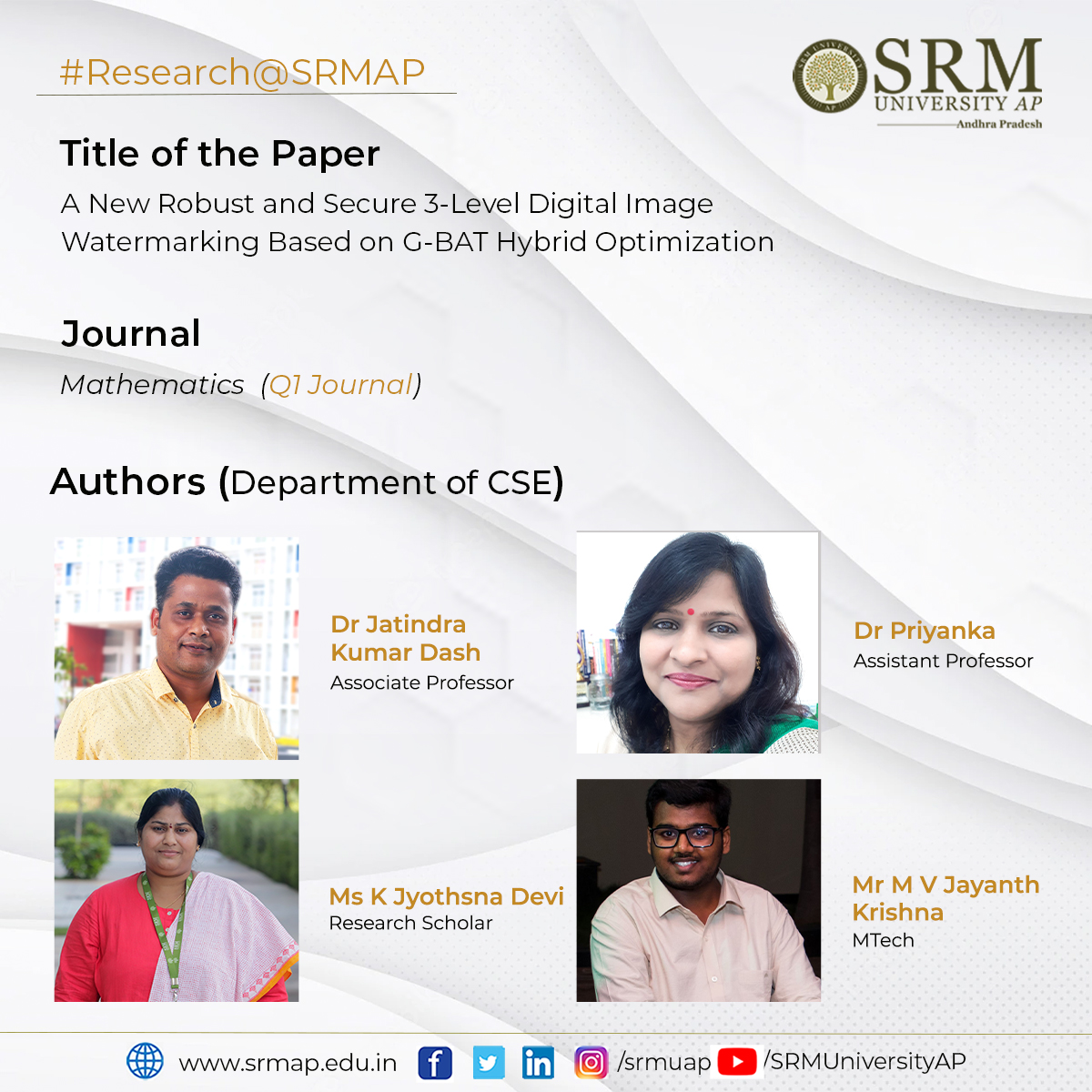 The research team from the Department of Computer Science and Engineering proposes a research scheme to address security concerns in the transmission of digital images of aerial Remote sensing images over the Internet. Assistant Professor Dr Priyanka, Assistant Professor Dr Jatindra Kumar Dash, research scholar Ms K Jyothsna Devi, and BTech student Mr. M V Jayanth Krishna, published the paper A New Robust and Secure 3-Level Digital Image Watermarking Based on G-BAT Hybrid Optimization in the Mathematics Journal SCI, a Q1 Journal with an Impact Factor of 2.9. The research project combats various threats in the transmission of Remote sensing images, such as copyright protection, copy control, and unauthorized access.
The research team from the Department of Computer Science and Engineering proposes a research scheme to address security concerns in the transmission of digital images of aerial Remote sensing images over the Internet. Assistant Professor Dr Priyanka, Assistant Professor Dr Jatindra Kumar Dash, research scholar Ms K Jyothsna Devi, and BTech student Mr. M V Jayanth Krishna, published the paper A New Robust and Secure 3-Level Digital Image Watermarking Based on G-BAT Hybrid Optimization in the Mathematics Journal SCI, a Q1 Journal with an Impact Factor of 2.9. The research project combats various threats in the transmission of Remote sensing images, such as copyright protection, copy control, and unauthorized access.Abstract
This contribution applies tools from the information theory and soft computing (SC) paradigms to the embedding and extraction of watermarks in aerial remote sensing (RS) images to protect copyright. By the time 5G came along, Internet usage had already grown exponentially. Regarding copyright protection, the most important responsibility of the digital image watermarking (DIW) approach is to provide authentication and security for digital content. The main goal of the paper is to provide authentication and security to aerial RS images transmitted over the Internet by the proposal of a hybrid approach using both the redundant discrete wavelet transform (RDWT) and the singular value decomposition (SVD) schemes for DIW. Specifically, SC is adopted in this work for the numerical optimisation of critical parameters. Moreover, 1-level RDWT and SVD are applied to digital cover images and singular matrices of LH and HL sub-bands are selected for watermark embedding. Further selected singular matrices S LH and S HL are split into 3 × 3 non-overlapping blocks, and diagonal positions are used for watermark embedding. Three-level symmetric encryption with a low computational cost is used to ensure higher watermark security. A hybrid grasshopper–BAT (G- BAT) SC-based optimization algorithm is also proposed to achieve high-quality DIW outcomes, and a broad comparison against other methods in the state-of-the-art is provided. The experimental results have demonstrated that the proposal provides high levels of imperceptibility, robustness, embedding capacity, and security when dealing with DIW of aerial RS images, even higher than the state-of-the-art methods.
The proposed scheme is easily dumped into the sender and receiver machines to work readily. MATLAB platform is the only requirement. Researchers aspire to design new image watermarking schemes using machine learning and deep learning techniques. For this project, they have collaborated with Professor José Santamaría from the Department of Computer Science, University of Jaén, and Professor Antonio Romero-Manchado from the Department of Cartographic Engineering, Geodesy, and Photogrammetry, University of Jaén.
Continue reading → - Save the Soil workshop in collaboration with Isha Foundation September 13, 2022
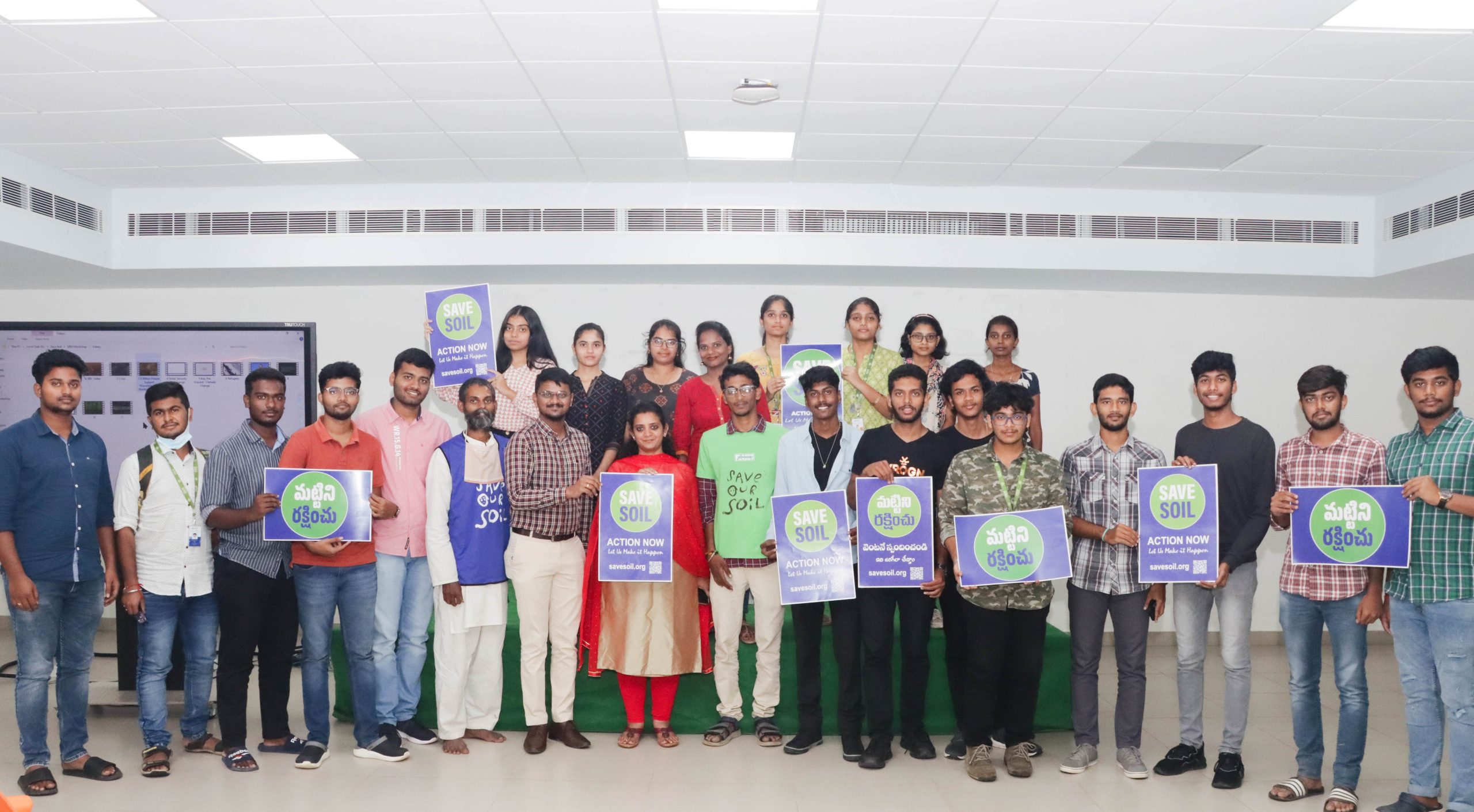
The Office of International Relations and Higher Studies in collaboration with Isha Foundation conducted a workshop “Save the Soil” for the students of SRM University-AP. The workshop intended to create awareness among the student community on the necessity of soil conservation. The Save Soil Movement is a global campaign spearheaded by the visionary, Sadhguru, to address the soil crisis and take a pioneering initiative towards the restoration of the planet.
As part of the workshop, students were given awareness classes and lectures on soil conservation and the deteriorating scenario of nature such as agricultural degradation, land pollution and soil erosion. An elaborate overview on the extensive damage inflicted on soil due to various human activities was discussed during the workshop. The soil extension and soil management ventures initiated recently brought attention to the degrading status of soil health due to excessive carbon footprint.
Students were also introduced to numerous techniques to improve the soil condition and reinstitute its fertility. The Save Soil movement advocates traditional conservation practices such as crop rotation, contour farming, conservation tillage etc., to retain and enhance the organic content of soil. The movement aims at establishing long-term policies that give special emphasis to addressing the soil crisis by uniting people, associations, and governments on a global scale. Raising awareness among students is the need of the hour to give rise to a conscientious generation capable of instigating a preservative outlook towards nature unlike in the past.
Around 60 students from different departments attended the three-day workshop that was held on September 05, 06, and 09. The Senior Programme Coordinator, Mr Sandeep Samala, encouraged the students to be part of the Save Soil campaign by registering on the portal. Dr Naga Swetha Pasupuleti, Associate Director, appreciated the Save the Soil – Isha volunteers for successfully conducting the workshop.
Continue reading → - Kick-starting placement 2023 with Marquee offers upto ₹26.50 LPA September 12, 2022
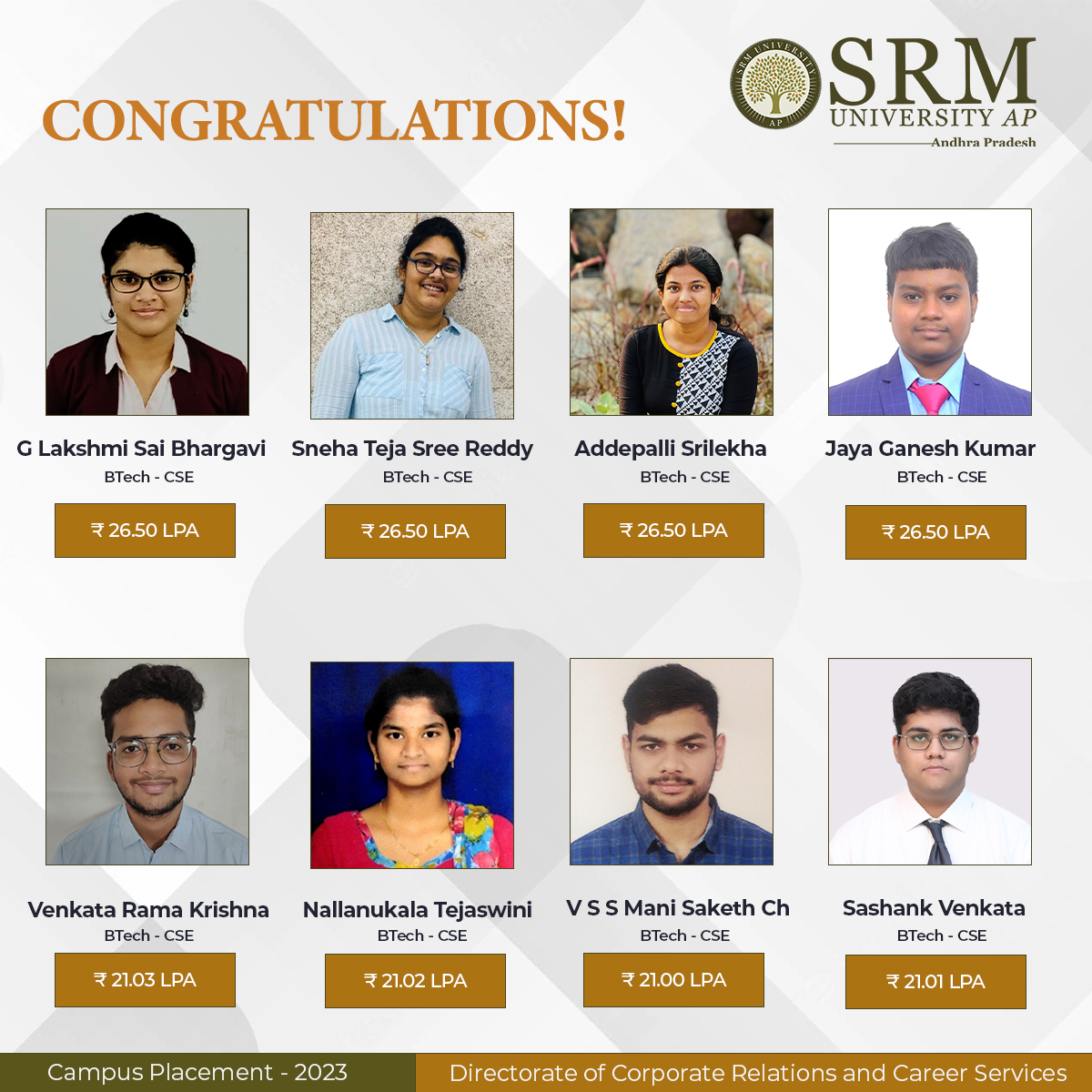 The Engineering students of SRM University-AP never failed to excel in the competitive placement drives with their unrivalled fervour. The Department of Computer Science and Engineering students are beyond thrilled about their placement with Marquee offers up to ₹26.50 LPA. G Lakshmi Sai Bhargavi, Sneha Teja Sree Reddy Thondapu, Addepalli Srilekha, Jaya Ganesh Kumar Gudipati, V S S Mani Saketh CH, Sashank Venkata Challapalli, Nallanukala Tejaswini, and Satti Venkata Rama grabbed marquee offers with incredible salary packages.
The Engineering students of SRM University-AP never failed to excel in the competitive placement drives with their unrivalled fervour. The Department of Computer Science and Engineering students are beyond thrilled about their placement with Marquee offers up to ₹26.50 LPA. G Lakshmi Sai Bhargavi, Sneha Teja Sree Reddy Thondapu, Addepalli Srilekha, Jaya Ganesh Kumar Gudipati, V S S Mani Saketh CH, Sashank Venkata Challapalli, Nallanukala Tejaswini, and Satti Venkata Rama grabbed marquee offers with incredible salary packages.The placement team of the university considers and analyses major recruiting companies’ criteria to equip our students to meet the various levels of constantly transforming industry demands. Students are instructed and trained from the very beginning of their programmes to know the pulse and challenges of the tomorrow they are exposed to. “The Placement team helped me a lot by introducing many Marquee companies at the beginning of academic years, which made me work faster on my skills”, says Mani Saketh with gratitude. “The way they helped us by conducting constant training sessions and responding very quickly whenever we had a single doubt or concern is commendable”, he added.
Making students industry-ready has always been a significant concern of the university. The courses provided in the university are supported not only by soft skill training but also by professional training. “There is always the possibility of starting from scratch here. Daily technical assessments helped us understand the industrial standards and requirements”, said Srilekha as she recollected her training days.
The Directorate of Corporate Relations and Career Services firmly believes that the latest placement offers marks just the beginning of the 2023 placements. Year after year, there is a considerable increase in the number of students recruited from the university. The placement team expects much more quality offers in the new placement season.
Continue reading → - Defect detection algorithms September 9, 2022
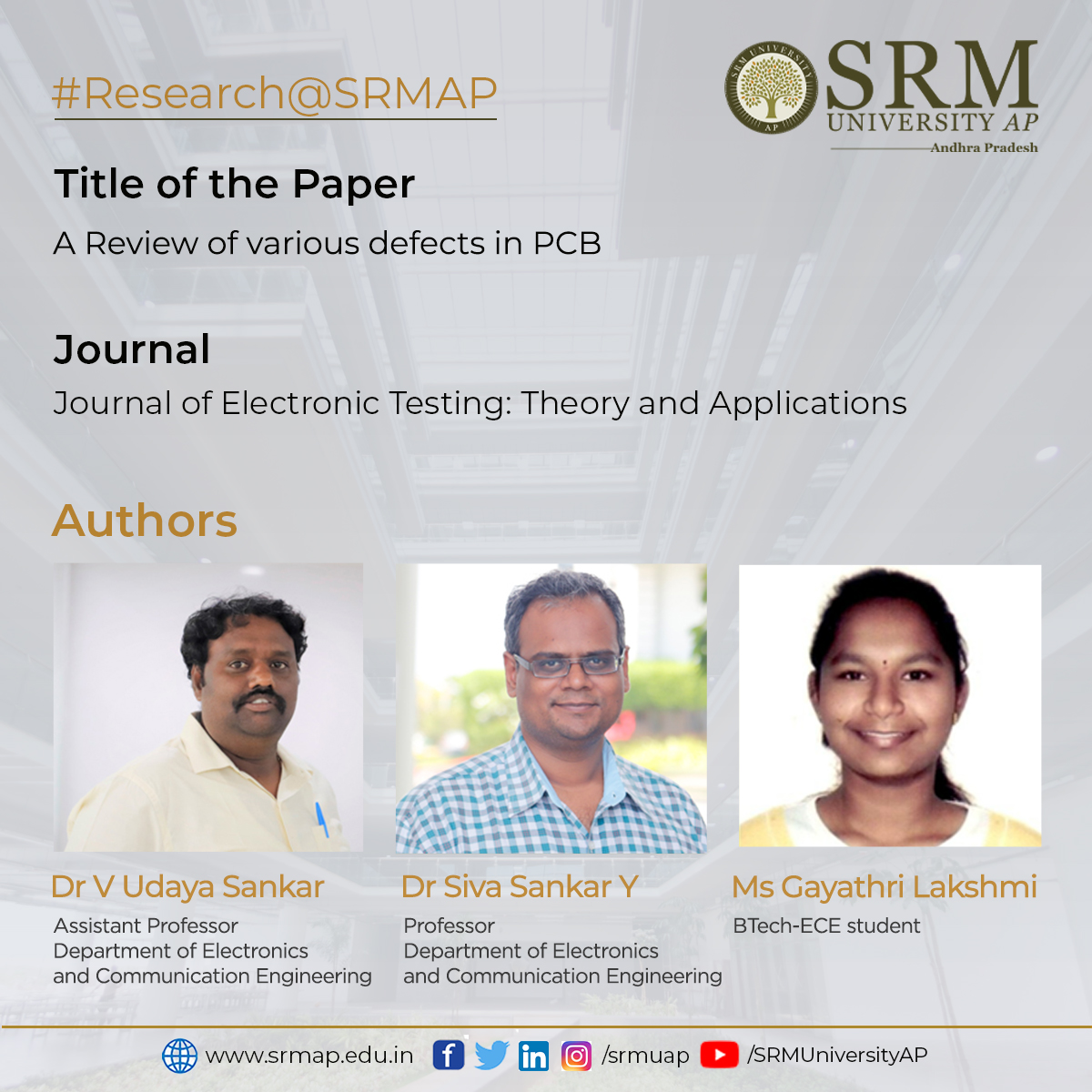 Research at the Department of Electronics and Communication Engineering is currently developing defect detection algorithms. Assistant Professor Dr V Udaya Sankar, Professor Dr Yellampalli Siva Sankar, and their BTech student Ms Gayathri Lakshmi have published a paper, A Review of various defects in PCB, in the Journal of Electronic Testing: Theory and Applications with an impact factor of 0.795.
Research at the Department of Electronics and Communication Engineering is currently developing defect detection algorithms. Assistant Professor Dr V Udaya Sankar, Professor Dr Yellampalli Siva Sankar, and their BTech student Ms Gayathri Lakshmi have published a paper, A Review of various defects in PCB, in the Journal of Electronic Testing: Theory and Applications with an impact factor of 0.795.Abstract
Printed Circuit Boards (PCBs) are the building blocks for all electronic products. Fabrication of a PCB involves various mechanical and chemical processes. As obtaining accuracy in the mechanical and chemical processes is very difficult, various defects/faults are formed during PCBs fabrication. These fabrication defects lead to performance degradation of electronic products. This paper describes multiple defects present in PCBs under the Through-hole and SMD categories. To understand the frequency of occurrence and reason for defects in both manual and machine, PCB fabrication data was collected and analysed from April 2017 to July 2020 as a part of industry collaboration.
The research is a review done on the defects present in PCB. Researchers surveyed various papers on PCB defects and their detection. Based on the literature review and information obtained from Efftronics systems Pvt. Ltd, they classified the defects, gave a detailed explanation for each, and provided some analysis of their occurrences.
While doing the literature review, researchers observed that no paper mentioned all the defects that can occur in the case of PCB fabrication. For this reason, they came up with this paper which provides detailed information regarding the defects. Information is also obtained from the industry. Comparing the defects can help focus on the critical defects for future research on defect detection methodology.
The project is done in collaboration with Efftronics Systems Pvt. Ltd. Through the partnership, the company supported sharing images, insights information related to defects and involved in discussions. Also, the company allowed visiting their premises to understand more about PCB defects. Researchers look forward to creating a prototype that detects all the defects mentioned in this paper for a given PCB.
Continue reading →


